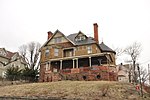Alexander Smith Carpet Mills Historic District

The Alexander Smith Carpet Mills Historic District is a national historic district located at Yonkers, Westchester County, New York. It includes 85 contributing buildings. It encompasses 19 stylistically varied mill buildings and six rows of workers' housing. They were developed between 1871 and 1930 in the vicinity of northeastern Getty Square along the banks of the Saw Mill River. The main mill building was originally built in 1871 and expanded between 1876 and 1883. It is a three-story, rectangular building, 52 bays wide and five bays deep in the Second Empire style. It features a four-story tower and a five-story tower. The workers' housing, known as Moquette Row, North and South, was built between 1881 and 1886. Many workers that lived in this housing originally were immigrants to the United States. They came from Scotland, Ireland, and Ukraine. The carpet works were developed by Alexander Smith (1818-1878) The company closed the Yonkers mills and relocated to Greenville, Mississippi, in 1954. At the time of its closing, there were 2,400 who worked at the carpet mill. At the time of World War II, there was 7,000 employees who worked at the mill.It was later absorbed into Mohawk Carpet, later Mohasco Corporation. The carpet weaving industry was revolutionized by looms invented in this plant by Alexander Smith and Halcyon Skinner. Skinner, an engineer, designed a loom known as the Axminster power loom (also known as the Moquette Loom), which revolutionized the production of carpets. A patent for this loom was created in 1877 and royalty rights were sold to European and American companies at the rate of twenty cents per yard of carpet produced.It was added to the National Register of Historic Places in 1983. Today, members of the YoHo Artist Community work out of two of buildings, located at 540 and 578 Nepperhan Avenue.
Excerpt from the Wikipedia article Alexander Smith Carpet Mills Historic District (License: CC BY-SA 3.0, Authors, Images).Alexander Smith Carpet Mills Historic District
Nepperhan Avenue, City of Yonkers
Geographical coordinates (GPS) Address Nearby Places Show on map
Geographical coordinates (GPS)
| Latitude | Longitude |
|---|---|
| N 40.9425 ° | E -73.883611111111 ° |
Address
Nepperhan Avenue 498
10701 City of Yonkers
New York, United States
Open on Google Maps







